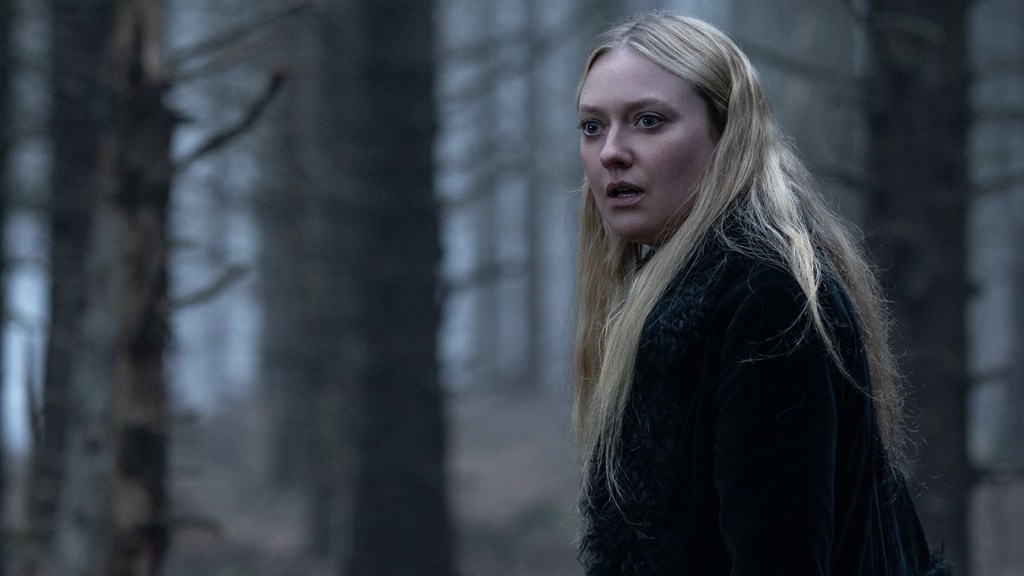
Dakota Fanning in ‘The Watchers.’
Jonathan Hession
[This story contains spoilers for The Watchers.]
As an artist, it’s no easy task to define oneself, to showcase a perspective and style that differentiates you from others. And it’s always that “other” that looms large, impacting your and everyone else’s perceptions of you. This is certainly the case for Mina (Dakota Fanning), a young, directionless artist whose car breaks down in the ancient woods of Ireland where she finds herself lost, in more ways than one, in The Watchers, based on the novel by A.M. Shine.
The film marks the feature debut of 24-year-old Ishana Night Shyamalan, daughter of cinematic storyteller, M. Night Shyamalan. The younger Shyamalan cut her teeth as a producer and director on her father’s the Apple+ series Servant, and as second-unit director on M. Night’s beach horror feature, Old (2021). With The Watchers, Ishana Shyamalan sets out to define herself as her own artist, while her father’s shadow, the one that audiences and studios created, looms large, both in terms of influence and the audience biases and expectations that have both helped and hindered his career. This is the story of two women, one a fictional character in a folklore-steeped horror film, and the other the writer and director of that film, finding their way out of the woods.
The way we are watched influences our behavior. Even when we’re told “just to act natural,” there is an element of performance. This is something Mina quickly finds out, despite her initial resistance, when she is ushered into The Coop by Madeline (Olwen Fouere), where she meets two other captives, the naively optimistic Ciara (Georgina Campbell) and the emotionally unstable and enigmatic Daniel (Oliver Finnegan).
The Coop, a haven from the outside world at night, consists of a single large room and a two-way mirror that spans the outer wall. It’s here that Mina and the others reside at night, staring back at their reflections, while outside of The Coop, the Watchers study them and applaud them…if they follow the rules that is. During the daytime, they are free to move as they please about the woods, to a certain point, as long as they return before sundown and stay away from the burrows where the Watchers dwell. It’s in these unwatched moments where the characters are allowed to be their most human selves. It’s a fantastic horror concept from Shine, which Shyamalan gets a lot of mileage out of, playing with the ticking clock, looming shadows and broken rules. But there’s also an underlying subtext to these nighttime performances that makes The Watchers all the more unique.

Ishana Night Shyamalan and M. Night Shyamalan at the Watchers world premiere in New York.
Steven Ferdman/WireImage
I’ve long been fascinated by code-switching, how people alter their language and behavior around different groups of people. It is a performance and a recognition that we are being watched, judged and chastised or applauded for our behaviors. It’s an act of self-preservation that typically has its roots in both race and culture. It’s clear early on that the Watchers are not same race, culture, or even species as those residing within The Coop. Thus, Mina, Madeline, Ciara, and Daniel alter their behaviors when being watched, becoming more deliberate in their actions, less relaxed, if such relaxing could even be done in this scenario, and they quickly fall into a certain pecking order with Madeline falling into a protective, mother-like position and the other three as children and siblings who cower and move cautiously behind the steadfast Madeline. But a film is not only about who we see on screen, but who is behind it as well.
If you consider yourself a Shyamalan scholar like myself, then you might already know that M. Night was born in Mahe, India as Manoj Nelliyattu Shyamalan, before his parents moved to Pennsylvania when he was six weeks old. Shyamalan spoke about his experiences growing up with Time ’s Christopher John Farley in 2000, where he said he felt like an outsider in Catholic school and was told he’d go to hell for being Hindu, which later sparked his fascination with religion. He also admits to putting a lot of pressure on himself as a filmmaker, something that undoubtedly grew partially as a result of Newsweek dubbing him “The Next Spielberg” in 2002, a moniker no rising filmmaker should ever have to contend with. Over the years we’ve all witnessed reviews that feel oddly targeted and the cruel mispronunciation of his name.
As a young Indian-American filmmaker in Hollywood dubbed “the next big thing,” surely there was some pressure to perform according to expectations, professionally and at the box office. While it’s conjecture, based on what The Watchers grapples with, there is a sense that Ishana Night Shyamalan, who has likely witnessed the highs and lows of her father’s career, is considering the full conditions of what it means to be watched. This is showcased in the way she handles these characters and their sensitivity to being boxed in, exposed, and having their stories judged.
When we first meet Mina, she’s working at a pet shop. It’s the 15th anniversary of her mother’s death, an act which she blames herself for, an act that has led her to abandon America, and her twin sister, for the anonymity Ireland can provide. The television in the shop shows a news report about the destruction of natural habitats, which has forced local animal and plant species to flee. We’re offered glimpses of newspapers in the film as well, headlines concerning deforestation and climate change. It’s impossible not to see the seeds of her father’s The Happening (2008) still clinging to Shyamalan all these years later, as like him, she seems concerned with the environment and the destruction of the natural order of things. We come to understand the Mina too has been pushed out, her natural order left in disarray as she flees her past. She is only comfortable adopting wigs and costumes and visiting local pubs in an attempt to be seen as someone else, or fit in, something some species of plants and animals do as well when forced to find new grounds. And like Darwin, the pet shop bird she finds herself looking after, she too is caged by her circumstances, unable to fly.
So just who or what are these mysterious Watchers in the woods? It’s important to remember here, as I think many failed to do with M. Night at a certain point in his career, that The Watchers is more than just a horror movie. It’s a modern fable, a fairy tale that arguably goes beyond what Shine’s novel conveys because of the difference in perspective the medium of film can provide. The Watchers are faeries, or changelings — creatures from Irish folklore who can change their faces and bodies to reflect humans.
Once, they lived in harmony with the humans, were worshipped as gods, and became willing mates to humans and produced offspring, halflings. Then, humanity began to fear their differences, their powers of change, and the capability of their children. So, they locked the faeries deep underground. They spent centuries crawling their way up to the surface, shedding their wings, and beautiful forms to emerge as the monstrous, twisted-bodied Watchers, not content to live among humans but to study and replace them. It’s this aspect, that seems to have lost some people. Yet, it is essential to fully appreciate The Watchers and the perspective the film offers.
Within this fairy tale, three things are grappled with: colonialism, miscegenation and appropriation. As a Black person, these aspects in the film stood out to me and elevated The Watchers beyond the sheer thrill of its genre. But beyond my connection to the film, these aspects also have clear ties to India’s invasion by Europe, the immigration and assimilation of Indians in English-speaking parts of the world, and the “Orientalism” that resulted in the theft of their artifacts and culture.
Humans are always fascinated by humans who are different than them, until they covet what they have and in turn fear it, and the possibility that miscegenation will erode their existence. As a result, homes are destroyed, toxins pollute the air, and the indigenous inhabitants of the land are either pushed out or trapped in increasingly smaller spaces: coops. This is the history of the world, now and then, and it is perhaps made more digestible through the lens of horror and fantasy, and easier to accept when seen through the eyes of a young white woman. Whether a fully conscious effort, The Watchers feels like a purposeful attempt from a young filmmaker to look at the world she’s grown up in, influenced as much by her father’s work and the history of her culture, as by the new cycle that defined her generation.
Much of The Watchers’ thematic weight deals with imitation and replacement, of watching and studying performance in a gamble to not only replicate it but do it better than the original subjects. Not only is Mina a twin (and the bad one in her own eyes), and someone who creates doppelgängers of herself through dress-up, but she also finds herself at the mercy of a Changeling, who at one point takes her form and threatens to replace her. The identity of this Changeling, who I won’t reveal here, does add another layer in terms of cultural theft, fear, and greed under the guise of academia. The only way Mina can escape her cage and form her own identity is to embrace her past and connect with her family’s history and future.
It seems Ishana Night Shyamalan is committing to this very conceit with The Watchers, embracing several storytelling tenets that make her father the filmmaker he is, as it is an inherent part of her artistic lens. She is recognizing and announcing herself as more than an imitation, but her own filmmaker whose influence we can recognize but whose artistry we should define on her own terms, regardless of the weight her name carries. In doing so we can look at how her experiences and historical knowledge, of her family, and beyond it, have shaped the cautionary optimism of this fairy tale that ultimately sees Mina free, though not unstudied and not unjudged. It’s an invitation to keep watching, to witness how this voice and lens develops throughout a career, and as long as Ishana Night Shyamalan continues to make films, that’s exactly my plan.









